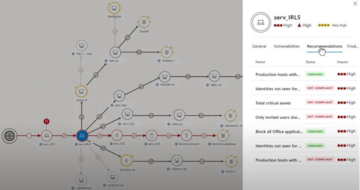
According to Microsoft, many companies use different security tools, but data often stays in one place, making it hard to assess threats. In a world where one weak spot can become a big problem, using a graph is key to seeing how assets, vulnerabilities and threats connect. This helps in taking action against risks, Microsoft added.
Just finding vulnerabilities is not enough, Microsoft said, adding that companies need to focus on solving the most dangerous vulnerabilities that attackers easily exploit. This change is a big step forward in cybersecurity, it said.
Earlier this year, Microsoft offered Security Exposure Management for a trial run, giving security teams basic tools for managing exposure. The suite has three parts꞉ Attack Surface Management, Attack Path Analysis and Unified Exposure Insights. These offer great visibility into risk areas.
Also read: Exclusive | Snapchat CEO discusses the mental impact of social media apps
Key Features

Microsoft Security Exposure Management. (Image: Microsoft)
1. Attack Surface Management꞉ Gives a continuous view of the organisation’s attack surface. Teams monitor exposure and focus on protecting critical assets.
2. Attack Path Analysis꞉ Shows dangerous attack paths. Teams target fixes and reduce risks.
3. Unified Exposure Insights꞉ Gives a clear look at threat exposure. Helps teams prioritise and answer important security questions.
Feedback During Trial Run
During the trial, Microsoft said it worked with customers and experts to improve the tool based on feedback. This cooperation helped shift to proactive threat management.
Quick Action
Microsoft said the Security Exposure Management tool helps organisations address critical issues quickly. By linking security insights, organisations see their risk clearly, which is important for decisions.
The tool helps companies build a Continuous Threat Exposure Management programme to be better prepared against threats.
More Data Connections
Microsoft added more data sources, including third-party tools, to Security Exposure Management. The tech giant said this helps companies have a complete view of their assets; Attack Path Analysis shows how attackers may use vulnerabilities.
Unified Role-Based Access Control (URBAC)
Microsoft now offers Unified Role-Based Access Control, letting organisations manage user access with custom roles, improving productivity and control.
As threats change and evolve, companies need active strategies to handle vulnerabilities. Microsoft said Security Exposure Management offers tools to focus, check and prepare teams against cyber threats.
Also read | Microsoft Ignite 2024: New Copilot features aim to simplify work, boost productivity



